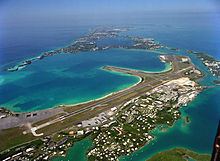Location St. David's Island Elevation AMSL 12 ft / 4 m 9,898 3,017 Elevation 4 m | In use 1970 - 1995 12/30 9,898 3,017 Asphalt Operator United States Navy | |
 | ||
Airport type Naval air station (Military) | ||
Naval Air Station Bermuda (Kindley Field), was located on St. David's Island, Bermuda from 1970 to 1995, on the former site of Kindley Air Force Base. It is currently the site of Bermuda International Airport.
Contents
History
The US Navy moved its anti-submarine air-patrol operations from the old NAS Bermuda flying boat base, to the USAF Base at Kindley Field when its Martin P5M Marlin flying boats were removed from service in the 1960s. They were replaced by Lockheed P-2 Neptune landplanes, which could not operate from the existing Naval Air Station, which had no hard surface runway ashore. The US Navy took over the airfield entirely from the USAF in 1970 and the base continued to operate anti-submarine patrols, first with Neptunes, then with Lockheed P-3 Orions. In the 1980s, the P-3s were occasionally augmented by carrier-based S-3 Vikings operating ashore, as well as Canadian Forces' Lockheed CP-140 Aurora and Royal Air Force Hawker Siddeley Nimrod MR.2 aircraft.
By the early 1990s, the range of submarine-launched ballistic missiles (SLBM) had so increased that Soviet submarines no longer found it necessary to come within range of Bermuda-based patrol aircraft in order to strike their targets in the United States. This was followed by the dissolution of the Soviet Union in 1991 and a general lessening of tensions between the now renamed Russian Federation and the US.
Reflecting these developments, the US Naval air detachment at Bermuda had been steadily reduced from a full squadron of Regular Navy P-3Cs on six month rotations to an average of three P-3B or P-3C aircraft, primarily from Atlantic Fleet Navy Reserve P-3 squadrons on 60-day rotations, plus the air station's own UH-1N Twin Huey search and rescue aircraft. In 1992, a scathing investigative report by Sam Donaldson, of ABC News, labelled the base as the 'Club Med of the Navy', because of its questionable use by senior military officers and DoD civilian and other U.S. Government civilian officials as a de facto vacation retreat. Subsequently, all three US Naval bases in Bermuda were slated for closure by BRAC. Except for the NASA tracking station on Coopers Island (at the Eastern End of NAS Bermuda), all US facilities in Bermuda were closed in 1995.
The Bermudian government took over operation of the field in 1995, being obliged to spend a great deal of money making it conform to international civil standards. This involved changes to lighting systems, fencing, and razing any objects over a certain height, within a certain distance of the runway (which included both the former base commander's residence, and the hillock it stood on). The US Government still held the lease, which was for 99 years, however, until negotiations were completed regarding the cleanup of toxic waste left behind. The cost of clean-up of all US Navy facilities in Bermuda was then estimated at $65.7 million, although that included $9.5 million for replacing the Longbird Bridge. Threats were made that, if the Bermuda government did not allow the US Government to wash its hands of responsibility, the US Navy would take the field over again and close it to all air traffic. The final compromise negotiated by the UK, Bermuda, and USA governments, which comprised an $11 million payment for the replacement of Longbird Bridge, has been denounced by many in Bermuda as a betrayal, but the field has now been transferred entirely to the Bermuda Government as the Bermuda International Airport. It was an alternative landing site for NASA's Space Shuttle.
Areas for clean-up identified in 1997 by a private contractor were:
The estimated cost was $65.7 million:
The lands which hosted the base were formally returned to Bermuda in 2002.
